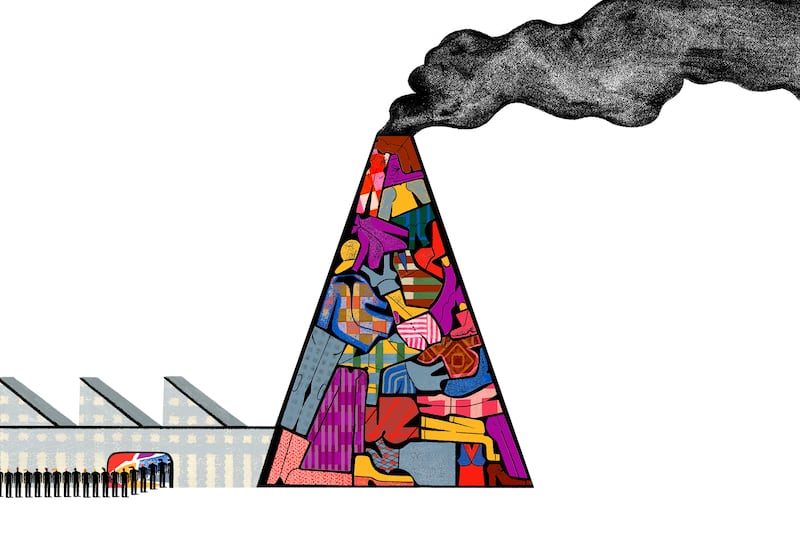Fast fashion has made it easier than ever to buy something fun to wear. But at what cost? Brands like Shein, Urban Outfitters and H&M pump out new products at unprecedented rates, bringing trends and runway knockoffs to market in weeks or even days. They offer unfathomable variety at very low prices, via Instagram ads and shopping malls.
The sector is worth $120 billion globally — expected to reach $185 billion in five years — and employs 300 million people. But lurking behind this success story are negative impacts of similar scope, involving labor practices, environmental impact and the proliferation of intentionally poor-quality products.
15 Days to market
That was the meteoric design-to-distribution timeline for Zara when its first store opened in 1975. At a time when most apparel companies released four new collections a year – one for each season – that speed helped the new company to put haute couture concepts within reach for typical consumers. Zara is now owned by Inditex, along with several other brands in this sector, which calls this approach the “democratization of fashion.”
54% synthetics
This self-reported stat describes the inventory of Boohoo, another booming online brand
that leads the industry in the percentage of clothing containing synthetic fibers. These fibers include polyester, a common type of plastic derived from petroleum that can contain toxic chemicals like PFC, which are harmful over time, especially for small children. These fabrics release polluting microplastics with every wash and won’t biodegrade for generations.
“Originally, the Zara and H&M folks were considered the fastest because they started delivering (new products) six then 12 then 18 then 24 different times a year. Now we’ve gotten to the next level with Boohoo and Shein introducing up to thousands of styles a day” —Kenneth Pucker, former Timberland COO
Five bucks a pop
Shein recently offered a plaid bolero jacket, a royal blue dress with ruffles and white polka dots, a beanie with a spider web graphic, or an emerald baseball cap with “LA” embroidered across the front, each for less than a rotisserie chicken from Costco. Based in China, Shein cycles up to 600,000 products at any given time through its online store, also visible through its app, the most downloaded shopping app in the world.
A truckload of trash each second
That’s how many fast-fashion discards end up in landfills and burn piles around the world, according to the Ellen MacArthur Foundation. More than half of these garments are thrown out within a year. About 65,000 tons are shipped each year to a single port in northern Chile, destined to join a technicolor mountain of synthetic fabrics piling up in the Atacama Desert, over-shadowing the red rock canyons in scale. This trash heap is clearly visible from space.
A living wage for less than 2%
That’s the rate among more than 75 million fast-fashion factory workers worldwide. Many work up to 16 hours a day, seven days a week — including children. They are exposed to 8,000 different synthetic chemicals, some known to cause cancer. Companies save money shifting production to subcontractors in countries with minimal oversight, like Vietnam, India and Bangladesh — where workers for companies like Primark were among more than 1,100 dead and 2,500 injured when the nine-story Rana Plaza collapsed in 2013.
“Fast fashion’s reason for being is high turnover. It’s almost a genre of addiction. They’re being fed some looks by brands and designers and manufacturers that even if they don’t particularly love it, there’s almost an imperative to participate. People are shocked by their own consumption and there’s almost shame, or a disgust, that sets in that they have so much stuff. And then they have to indulge in some kind of purging ritual. —Nancy Deihl, author of “The History of Modern Fashion” and professor at New York University.
A quarter of all emissions
By 2050, the global fashion industry is expected to produce 26 percent of all greenhouse gas emissions worldwide, driven largely by fast fashion. That’s up from about 4 percent in 2018, enough to match all emissions from France,
GEN Z’S CONUNDRUM
Pew Research Center has found that 69 percent of Gen Z and 59 percent of millennial users cite anxiety about climate change on social media. But these same demographic segments are fueling fast fashion. Consider #SheinHaul, a hashtag on TikTok where users post videos of themselves unboxing massive orders, which has garnered more than 13 billion views; and alternatives like #closetpurge or #wardrobe- purge, with billions of their own.
Correction: An earlier version of this story incorrectly stated that Kenneth Pucker was the former Timberland CEO. He is the former Timberland COO.
This story appears in the December issue of Deseret Magazine. Learn more about how to subscribe.


